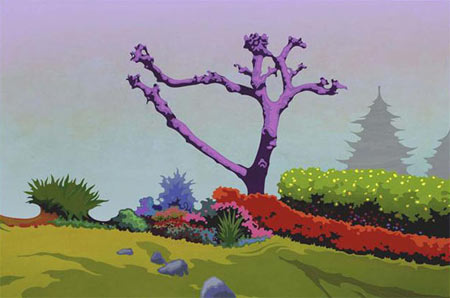
Contemporary American landscape painting has dislodged itself from the theories, goals and practices of esteemed nineteenth century Hudson River school artists like Thomas Cole and Asher Durand, who proclaimed that their attentive nature studies brought them closer to enlightenment and into alliance with God’s divine harmony. Majestic panoramas celebrating this country’s vast unspoiled wilderness, in the style of Albert Bierstadt or Thomas Moran, are more commonly seen now on calendars or travel ads than in art galleries or museums. Twentieth century regionalist landscapes that glorified the “uniquely American,” hardworking, prosperous lifestyle that once defined our mostly rural communities have gone the way of Life magazine. Instead, we turn to Newsweek’s recent list of “What to read now: the best books on greed, adultery, the food wars, the Pope, disasters, and the Taliban.”
Recognizing that there is currently little evidence of trust in earlier promises of divine harmony, unspoiled land or nationalized prosperity, Lisa Adams, Amir H. Fallah, Wendell Gladstone and Greg Rose conscientiously contribute work that reveals their hopes, dreams, fears and priorities to \"Prelude to an Apocalypse: Landscape in an Era of Diminished Expectations.\"
Rose’s serious concerns about the nature of the gesture in abstract painting turned him towards a more formalized approach to constructing the sublime. Awed by aesthetically idealized versions of forms found in nature, Rose draws inspiration from the study of disciplines as diverse as ikebana, bonsai, anime and planned residential landscaping to enrich his work. After developing his compositions in Photoshop, Rose constructs stencils cut from masking tape to mark off sections of his canvas. With the application of an intriguing range of colors and variety of painted surfaces to his canvas, his own personal paradise begins to emerge. In “Arcadia and Bedford Lane” we sense Rose’ recognition of the multi-cultural diversity of our communities through his incorporation of a variety of vegetation, imported from any area of the world Sunset Western Garden Guide suggests might have a chance to take root here.
Imagery in Lisa Adams’ paintings is frequently culled from a collection of her own photographs of objects that intrigue and/or mystify her. Adams’ selections “stem from a desire to suffuse sources of inchoate matter – the formal elements, the grist of art – with a deeply felt, psychologically-charged world-view.” Her personal integrity merges with more universal concerns, cathartic to the artist and compelling to the viewer. A white rectangle representing a trunk, painted to repel damaging insects, elevates her pollarded tree bedecked with RBG process color stained glass inserts in “Privilege Entails Responsibility.” Associations with Mondrian’s early attempts to reconcile the structural elements evolving in his portrayals of trees with his spiritual pursuits through neoplasticism seem relevant. An echo of this conversation emerges in the hieratical progression from ambiguity to high realism as one moves up the canvas in “Ineluctable.” The truncated, anthropomorphic stump from “Franklin Canyon,” marked with Kristy’s eternal declaration of love for Ryan in “A Morass of Contradiction” is backed by an altar of ascending angular forms, triggered by Adams’ recollection of elements in a Malevich Suprematist composition.
Wendell Gladstone isn’t afraid of defacing his images “in order to change tempo or shift meaning.” He cleverly connects often troubling, disparate objects, pulling the viewer through time, space and a range of emotional reactions with his adroit handling of form and texture. A nightmarish, flushed, psychedelic head with candy cane striped rope threaded through its orifices is bound to a floating pointillist figure, pouring liquor from a bottle under the eye of a gaggle of what appears to be drunken sailors in “Sanguine.” One need not identify the exact origins of each individual element to become engaged in the stirring impact of Gladstone’s work. Children sourced from an old German chocolate advertisement in “Headdress Oral History” serve to suggest the idea of youth and consumption. Transformations achieved in that work including Gladstone’s placement of a morphed parade of toy soldiers around the more liquid, mustached shaman’s face encourage multiple readings. The white, bas-relief, plaster-like figures in both paintings take on the role of a Greek chorus.
Although highlighted by brilliant atmospheric gradations of background color, the precariously balanced tree house in Amir H. Fallah’s “Terminator” suggests a world teetering close to the brink of collapse. This in spite of the efforts of body builders who flex their muscles in poses reminiscent of those seen on posters young boys tape to hideaway walls as objects of inspiration. A house of cards cantilevered into space, “An Altar For Your Life, For your Death” plays off fragments, facets, dislocations and juxtapositions of imagery of the sort one might find in “Beautiful/Decay,” a magazine Fallah has published since he was 16 years old. The border encircling each work references Iranian miniature painting and Fallah’s cultural heritage.
While each of the artists in this exhibition reflects his or her own being in their work, an overlying anxiety as to how our relationship to nature will play out in the future is reflected in their intriguing updates of trusted ideas of landscape painting.
Published courtesy of ArtSceneCal ©2010
